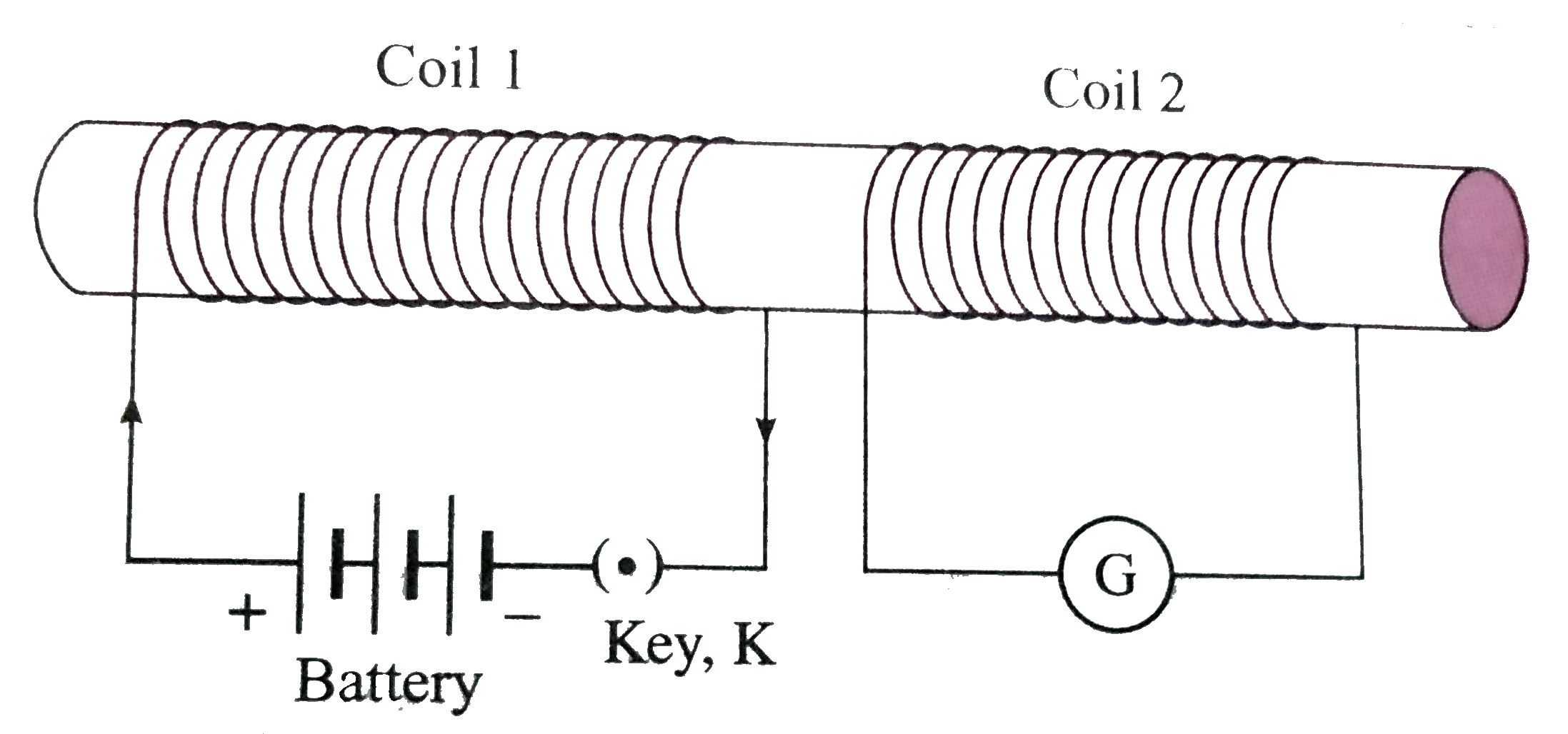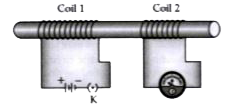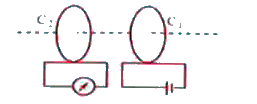Take two coils of about 50 turns. Insert them over a nonconducting cylindrical roll as shown in Fig. 4.23. (A thick paper roll can be used.) Connect coil 1 to a battery with a plug key K. Connect coil 2 to a galvanometer G. (1) Plug the key and observe the deflection in the galvanometer. (2) Unplug the key and again observe the deflection. Note your observations. What conclusions do you draw from these observations?

Observations: (1) When the key is plugged, the galvanometer shows a momentary deflection. When the current in coil 1 becomes steady, the galvanometer shows zero deflection, i.e., its pointer returns to the zero mark at the centre of the scale.
(2) When the key is unplugged, the galvanometer shows a momentary deflection in the opposite direction relative to that in part(1) of the experiment. When the current in coil 1 becomes zero as the circuit is broken on unplugging the key, the galvanometer shows zero deflection, i.e., its pointer returns to the zero mark at the centre of the scale.
Conclusions : As the current in coil 1 changes, the magnetic field associated with the current changes. This induces an electric potential difference in coil 2 which gives rise to an electric current and hence the deflection of the galvanometer. The direction of the induced current and hence that of the deflection of the pointer in the galvanometer depends on whether the current through coil 1 increases or decreases with time.
When there is a steady current in coil 1, there is no change in the associated magnetic field and hence no production of induced potential difference in coil 2. In that case there is no current in coil 2 and hence the galvanometer shows zero deflection.
Topper's Solved these Questions
- EFFECTS OF ELECTRIC CURRENT Book:NAVNEET PUBLICATION - MAHARASHTRA BOARDChapter:EFFECTS OF ELECTRIC CURRENT Exercise:Give scientific reasons :
Explore 11 Videos
- EFFECTS OF ELECTRIC CURRENT Book:NAVNEET PUBLICATION - MAHARASHTRA BOARDChapter:EFFECTS OF ELECTRIC CURRENT Exercise:Distinguish between the following :
Explore 3 Videos
- EFFECTS OF ELECTRIC CURRENT Book:NAVNEET PUBLICATION - MAHARASHTRA BOARDChapter:EFFECTS OF ELECTRIC CURRENT Exercise:Answer the following questions in one sentence each :
Explore 4 Videos
- DISTINGUISH BETWEEN THE FOLLOWINGBook:NAVNEET PUBLICATION - MAHARASHTRA BOARDChapter:DISTINGUISH BETWEEN THE FOLLOWINGExercise:Animal Classification
Explore 1 Video
- EXPLANATION AND GIVING CONCEPTS Book:NAVNEET PUBLICATION - MAHARASHTRA BOARDChapter:EXPLANATION AND GIVING CONCEPTS Exercise:ANIMAL CLASSIFICATION
Explore 2 Videos
Similar Questions
Knowledge Check
The deflection in moving coil galvanometer is
Adirectly proportional to the torsional constantBinversely proportional to the area of the coilCinversely proportional to the currentDdirectly proportional to the number of turns in the coilThe deflection in a moving coil galvanometer is
ADirectly proportional to the torsional constantBDirectily proportional to the number of torsional coilCInversty proportional to the area of coilDInversely proportional to the current flowingThe deflection in a moving coil galvanometer is
Ainversely proportional to number of turns.Binversely proportional to current flowing.Cinversely proportional to area of the coil.Ddirectly proportional to the magnetic field strength.
Two circular coils-1 and coil-2 are kept close to each other as shown in the diagram. Coil-1 is connected to a battery and key and coil-2 with a galvanometer. State your observation in the galvanometer:

(a) When key K closed.
(b) When key K is opened, Give reason for your observations.
View SolutionTwo coils C1 and C2 are kept coaxially as shown the coil C1 is connected to a battery and the coil C2 is connected to a galvanometer. The deflection in galvanometer can be increased by

View SolutionWhat is the effect on the deflection of a galvanometer attached to a coil, if a magnet is moved closer to the coil?
View SolutionA coil made of insulated copper wire is connected to a galvanometer. What will happen to the deflection of the galvanometer if a bar magnet is pushed into the coil and then pulled out of it? Give reason for your answer and name the phenomenon involved.
View SolutionA coil of insulated wire is connected to a battery. If it is connected to galvanometer, its pointer is deflected, because
View Solution
